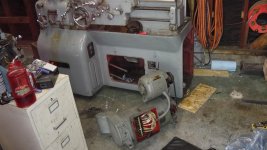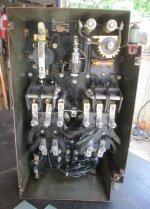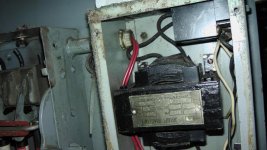On changing something in the drive ..
an AC brushless servo drive is vastly, and I mean vastly, better than anything else.
AC servo == 5x better than anything else, per power in HP.
--
Conclusion here:
AC servo drive 2.5 kW == better than a 12 kW VFD+3 phase motor.
IME.
Not opinion, experience.
I never ever thought huge torque and steady speed would be so important.
I got the servo for C axis, basically.
The torque benefit was a total surprise for me.
I never, ever, thought I needed more torque or better more stable spindle speed.
My drive and spindle were very good, pre servo, imo, ime.
--
AC servo is expensive vs cheap 3 phase, but very much cheaper than dc / replacement stuff.
My lathe got a 2.5 kW (cont) AC servo of 220 V (50 HZ, EU), at 1:3 belt drive via HTD 8-30.
Vs original 1.5 kW induction motor, 220V, industrial.
The AC servo delivers 90 Nm of torque 0-1000 rpm, sub ms stop on errors, crashes, or overloads.
For comparison a HAAS ST10 delivers 102 Nm peak 1200 rpm, less overall, much less at 10 rpm.
Idk, but the HAAS10 might have 10 Nm at 10 rpm, from 12 kW.
Typical for 3 phase motors and VFDs, somewhere around that.
Mine gets 90 Nm at 1 rpm, 30 Nm continuous forever, 0.1 ms reaction update, 0.03 ms stability / position update (30 kHz), perfect stable speeds with interrupted cuts (takes less than 0.1 mm (0.05 mm ) at edge of 150 mm steel workpiece to regain speed in an interrupted cut).
(12 kHz servo update rate, == 0.1 ms reaction time to whatever power/torque is needed, 30 kHz loop).
Essentially the servo drive delivers perfect power, torque, finish, at all rpm 0-1000.
And has similar performance to a 12.5 kW Haas turning center, in real-world use.
But very much better in stability, reaction, and VASTLY better safety in crashes.
Stuff bends but does not break because the servo faults so fast.
My servo costs about 2000€ for 2.5 kW, 22% VAT included EU.
A 4 kW AC servo might be 800€ more.
I got about 7x metal removal rate, vs results before, with exceptional finish.
3.5 mm DOC, 700 rpm, fast feed, ISO30 face mill, tool steel billet on very heavy fixture.
Cutting about 45 mm width (face mill 50 mm).
--
Note the servo drive needs a substantial mount and proper belts.
My motor mount == 50 kg in mass, 20 mm thick steel plates, 30x30 mm standoffs.
A 12 kg 4-jaw chuck of 10", 1000 rpm, workpieces 10-40 kg, has huge inertia.
Peak loads in a crash or estop or fast stop (vs halt) are easily 80 kW == 110 Hp in power for many ms, maybe 15 ms.
The servo drive dumps it into the grid, no problem in the EU at 220V single phase.
-
Should measure the time, energy dumped, and stop duration, actually, for curiosity.
-
The servo estops around 1 ms, 2 mm of error on diameter of 100 mm D, 120 counts, 1.5 degrees more or less angular on the C.
Tunable, to whatever one wants.
Within 1 ms the x and z axis and workpieces do not get damaged under catastrophic loads.
Or the TS overloading, I stalled the spindle 3-4 times with very large (25 mm D) drills in steel.
And 2-3 crashes on x due to interference, my error, mostly via MPG or jog.
--
My new VMC has a 2.2 kW 3-phase motor, now, due to economics.
Soonish, it will go to an AC servo.
I did not have the extra 3k€ to spare vs 109€ for 3-phase.
--
My point is that new AC servos are vastly, vastly, better than anything else if you are already considering 3-4-6000$ spends.
And cheaper.
And deliver about 2-4x the "power" because they have so much peak torque, about 300% of nameplate, 3 secs.
So a 2.5 kW AC servo, (mine), delivers more torque, better, than a 7.5 kW normal drive, almost always.
If one is continuously cutting at 7 Hp MRR, this does not hold, of course, if and only if the RPM is at the sweet spot for the old 7.5 kW motor+drive system.
Using belts and gears one is likely near the sweet spot for the 7.5 Hp motor at some given radius say 150 mm / 1000 rpm.
And can utilise maybe 6 Hp of output power.
At larger radius (torque, tool SFM), and smaller radius (speed), the 7.5 Hp motor wont deliver more than 3 Hp, typically.
The Monarch drive can deliver 7Hp on cutting a cylinder, at some near-optimum radius, rpm, feed, speed.
And do so extremely well.
A 2.5 kW AC servo would do about 60% of the MRR, maybe 65%.
A 4 kW AC servo might do near-enough the same (== 5.6 Hp sustained output) MRR as the Monarch drive.
In reducing a cylinder of 100 kg mass, steel, 50 cm long, 20 cm D (8"), by 80% to 4 cm D over 40 cm length cut vs 500 mm original length.
The Monarch drive would take about the same time as the 4 kW AC servo, servo probably a bit less.
Example:
Reducing 80 kg steel billet to chips in 20 cm D (maybe 1. mm DOC, maybe 2 mm DOC) would be limited by motor power.
The lathe has the rigidity and toolbits have the capacity.
Somewhere near 500 rpm, at 200 mm D, wag.
Would expect about 2 hours cut time, by tlar.
As the diameter goes down, 20 cm to 4 cm the Monarch would need some adjusting to maintain optimal performance.
--
I am NOT putting the Monarch drive down.
My Bridgeport M head with original 3 phase motor is circa 1940, about 80 years old, afaik.
The motor is excellent, near-silent sub 600 rpm, run forever at rated power output (1/2 Hp) 1400 rpm maybe.
It was the best motor US engineering could build, 1940, and the best in the world, +/-, at that time.
Masses 18 kg.
The 3000 rpm AC servo on the lathe, 15 kg, 2.5 kW sustained, is == 6x more powerful by mass.
Accelerates to 3000 rpm in 30 ms.
30 Nm peak upto 3 secs.
Twice the output shaft D, due to 5x better torque response, or more.
Double the shaft, bit smaller package, less heat at low/medium load, 6x more power output, positioning at 10.000 counts / rev, about 20x peak torque.
6x the power by size or mass.
Has less than half the heat losses due to engineering issues. (Inductance, ripple current, hysteresis).
12-15x the torque at usual speeds, much more at very high or very low speeds.
Point:
The best 3-phase motor, 1940, Bp, similar to a Monarch drivesystem in many ways.
Is about 6-18x weaker than a modern, cheap, AC brushless servo. (industrial, import, by me).
--
I would never spend 6000$ on Monarch electrical drive stuff.
3400$ or less would get a 4 kW (+/-) drive 6x better in every way, and 0-3000 rpm, as one wants.
Practically zero gear changes ever, removing gearing/belting being a practical option.
Or just run at 1:1 or .7:1 for 0-4000 rpm, if very heavy material removal is not common in large steel/CI pieces.
1:3 or 1:1 (or less) (timing) belts perhaps being an option, if one does turning of very small pieces under 2 cm in D, and one also needs to turn large steel pieces over 20 cm D / 8" with high power in MRR for efficient stock removal.








